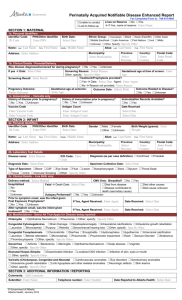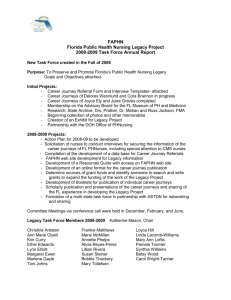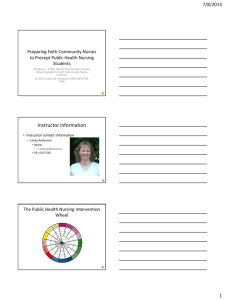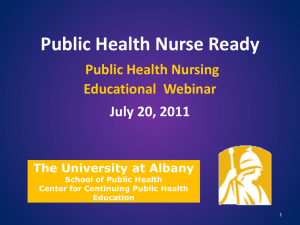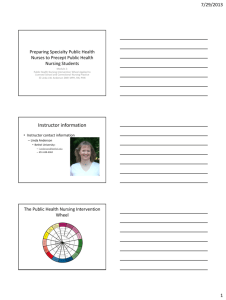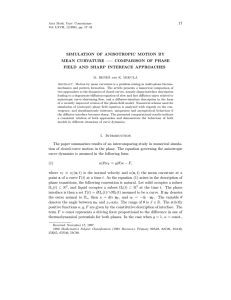Clinical Menu Population-Based Public Health Nursing
advertisement
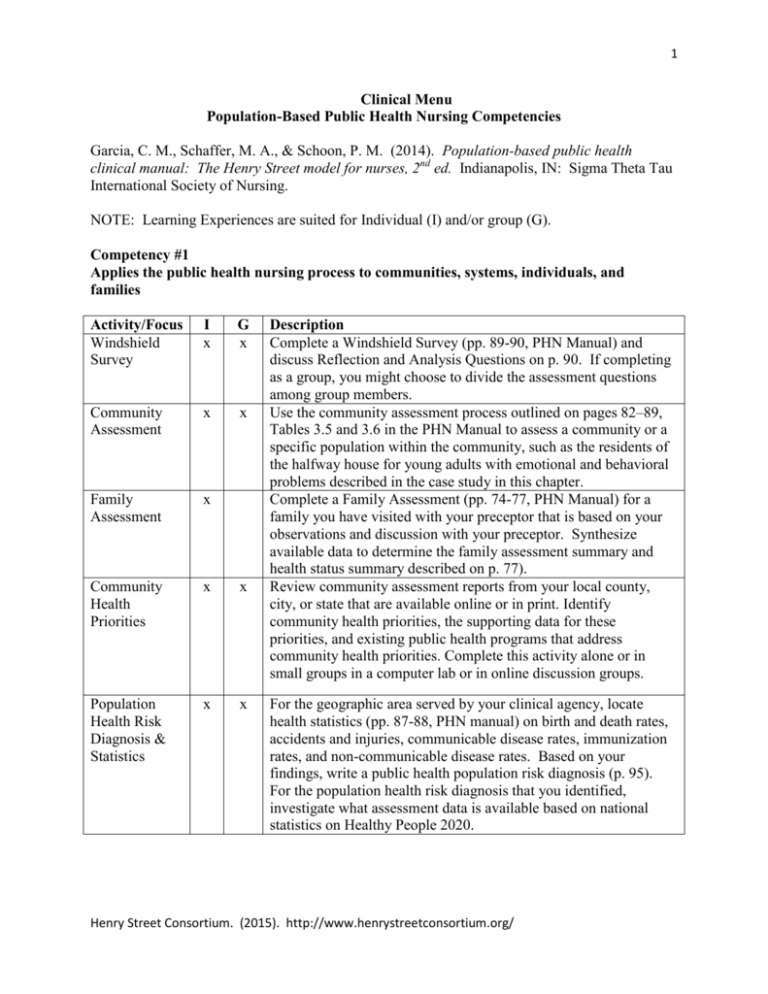
1 Clinical Menu Population-Based Public Health Nursing Competencies Garcia, C. M., Schaffer, M. A., & Schoon, P. M. (2014). Population-based public health clinical manual: The Henry Street model for nurses, 2nd ed. Indianapolis, IN: Sigma Theta Tau International Society of Nursing. NOTE: Learning Experiences are suited for Individual (I) and/or group (G). Competency #1 Applies the public health nursing process to communities, systems, individuals, and families Activity/Focus Windshield Survey I x G x Community Assessment x x Family Assessment x Community Health Priorities x x Population Health Risk Diagnosis & Statistics x x Description Complete a Windshield Survey (pp. 89-90, PHN Manual) and discuss Reflection and Analysis Questions on p. 90. If completing as a group, you might choose to divide the assessment questions among group members. Use the community assessment process outlined on pages 82–89, Tables 3.5 and 3.6 in the PHN Manual to assess a community or a specific population within the community, such as the residents of the halfway house for young adults with emotional and behavioral problems described in the case study in this chapter. Complete a Family Assessment (pp. 74-77, PHN Manual) for a family you have visited with your preceptor that is based on your observations and discussion with your preceptor. Synthesize available data to determine the family assessment summary and health status summary described on p. 77). Review community assessment reports from your local county, city, or state that are available online or in print. Identify community health priorities, the supporting data for these priorities, and existing public health programs that address community health priorities. Complete this activity alone or in small groups in a computer lab or in online discussion groups. For the geographic area served by your clinical agency, locate health statistics (pp. 87-88, PHN manual) on birth and death rates, accidents and injuries, communicable disease rates, immunization rates, and non-communicable disease rates. Based on your findings, write a public health population risk diagnosis (p. 95). For the population health risk diagnosis that you identified, investigate what assessment data is available based on national statistics on Healthy People 2020. Henry Street Consortium. (2015). http://www.henrystreetconsortium.org/ 2 Competency #2 Utilizes basic epidemiological principles (the incidence, distribution, and control of disease in a population) in public health nursing practice Activity/Focus I G Description Risk and x Select two communicable diseases and two non-communicable Protective diseases relevant to the population served by your community. Factors Identify the relevant risk and protective factors for each disease. Epidemiology x x Walk or drive in the community served by your area. Based on the (general) geography and density of the community (urban, suburban, or rural), identify potential health problems that could be addressed by epidemiology Epidemiology x Find a local newspaper. Make a list of health problems addressed (general) in the articles. Select three problems and discuss how you could use epidemiology to learn more about the problem and intervene to reduce the problem. Epidemiology x Interview the epidemiologist or data person in your clinical agency (general) about how they use data to identify priority public health issues. Epidemiology x Explore the epidemiology of one of the following: a) body (high risk piercing, b) tanning beds, c) internet addiction behaviors) Epidemiology x x Explore the County Health Rankings website: (priority health http://www.countyhealthrankings.org/ issue) Based on a specific county, identify a priority health issue. How can epidemiology be used to address the problem? Lead x Find statistics about lead poisoning for your county. Identify who poisoning is providing services and what strategies are being used to reduce incidence Chlamydia x Complete the Learning Example on Population-Based data (pp. 135-137, PHN Manual). Determine how the statistics compare to the rate of chlamydia in the population served by your agency. Epidemiology x Download the App from CDC called Solve the Outbreak and Earn App Your Disease Detective Badge. http://www.cdc.gov/mobile/Applications/sto/ Epidemiology x x Epidemic: A mysterious disease is causing people to fall ill in your Game city. Join the team to stop the epidemic before it spreads throughout the city and beyond! Can be played alone or with up to three other players. Available free on the School of Public Health, University of Minnesota website. http://sph.umn.edu/ce/epidemic/ Henry Street Consortium. (2015). http://www.henrystreetconsortium.org/ 3 Competency #3 Utilizes collaboration to achieve public health goals Activity/Focus Community Resources I x G x Interprofessional Collaboration Interprofessional Collaboration Partnership Building x Partnership Building x x Partnership Building x x Collaboration x Community Assets x x x x Description Identify three resources in the community served by your public health agency (e.g. food shelf). Select one organization to visit, pick up information, and ask questions about how to refer persons who need services. Interview a public health staff member who is not a nurse about how they work with nurses and the skills and knowledge they contribute to public health practice. Make a list of the different disciplines of staff employed by your clinical agency and identify the contribution of each discipline to work of the agency and the health of the public. Complete the Healthy People 2020 exercise (p. 150, PHN Manual) and identify collaboration and partnership building strategies that could be used by the public health agency where you have your clinical experience). For a primary health concern in the community served by your agency, identify any existing partnerships that exist to respond to the problem. Interview someone in the partnership about partnership strategies. Or, discuss possible partners and strategies that could be used to develop and effective partnership. Walk or drive through a business district or visit the county or city seat of local government. Identify possible professionals or organizations for development of partnerships with the public health agency to promote population health. Explain which levels of practice would be emphasized in the partnership: individual, community, and/or systems. Find an evidence-based example of an effective collaboration in public health and discuss the feasibility for implementing a similar activity/experience in your clinical agency. Walk and/or drive through a specific geographic area in the community served by your clinical agency. Create an Asset Map in drawings or electronic pictures or words. Henry Street Consortium. (2015). http://www.henrystreetconsortium.org/ 4 Competency #4 Works within the responsibility and authority of the governmental public health system Activity/Focus I G Description Immunization x Compare how childhood immunization is addressed from the medical model with the public health model. Find out what your clinical agency does to promote childhood immunization. Emergency x Find out what your clinical agency is doing for emergency Preparedness preparedness. Identify the contribution or role of various public health professionals in the emergency preparedness plan. Psychological x Psychological First Aid Tutorial: Describes the four core actions First Aid of PFA providers, reviews ways to engage with disaster survivors, lists common reactions to traumatic events, and provides an opportunity to check understanding in practice scenarios. http://sph.umn.edu/ce/perl/mobile/pfatutorial/ Referral for x x Identify community resources in your county that are available to Older Adults help older adults stay in their homes. Visit one of the organizations to learn about the referral process. Mandated x Identify the process for mandated reporting of child abuse and Reporting for neglect in the county in which your clinical agency is located. Ask Child Abuse a PHN to describe the expectations for mandated reporting and how he or she balances the development of a trusting relationship with families with responsibilities for mandated reporting. National x x Discuss how your clinical agency is addressing the seven priorities Prevention identified by the National Prevention Strategy. See PHN Manual, Strategy p. 180. Government x Investigate public health laws or regulations on vaccines or Regulation smoking in public places. Identify which level of government oversees the law or regulation: local, state, or federal. Breastfeeding x Explore how you could use the Business Case for Breastfeeding Policy website to work with an employer in your community to support women’s opportunities for breastfeeding. Essential x x Walk and/or drive through a specific geographic area in the Public Health community served by your clinical agency. Based on your Services observations, analyze which of the 10 Essential Public Health Services is provided or supported by your clinical agency. See Table 1.4, “Ten Essential Services of Public Health” on pages 1516, PHN Manual. Morbidity and x x Based on morbidity and mortality statistics for the city or county Mortality served by your clinical agency, select one disease or health Statistics problem that impacts the health status of the population. Investigate local, state, and national responses to address the selected problem. Search government websites to locate resources and programs to address the problem at all three levels. Include Healthy People 2020, cdc.gov, state health department, and county health department. Also, refer to your clinical agency’s annual report. Henry Street Consortium. (2015). http://www.henrystreetconsortium.org/ 5 Competency #5 Practices public health nursing within the auspices of the Nurse Practice Act Activity/Focus PHN Knowledge and Skills I x G Preparation for Public Health Nursing Delegation x x Complete the delegation case study on p. 211 in the PHN Manual. Scope of Practice x Interview a PHN about his or her scope of practice at the individual/family, community, and system levels of practice. Which public health interventions from the Public Health Intervention Wheel (MDH, 2001) does the PHN use the most in practice? Which interventions is the PHN performing independently? What are some examples of delegated functions PHNs might do based on the Nurse Practice Act in your state? Discuss with one of your peers strategies you are both using to maintain professional boundaries in your care of clients. Discuss how social media impacts the challenge of maintaining professional boundaries. Discuss how rule ethics, virtue ethics, and feminist ethics can guide your decisions about using social media in public health nursing. Discuss with other students in your clinical group how to maintain professional boundaries in relationships with clients in community settings. Consider the following questions: 1) How do you balance “being professional” with establishing a caring relationship with your client; 2) In your relationships with clients in the community, what are potential areas for boundary violation; and 3) What can you do to avoid violating boundaries in public health nursing situations? Interview a school nurse or a nurse working in a jail or prison about their practice. Show the Public Health Intervention Wheel and ask which interventions they most frequently use. Ask about their activities that fall into the delegated functions intervention. Analyze two interventions identified by the school nurse to determine whether the interventions are at the individual/family, community, or systems level of practice. Find the Nurse Practice Act for your state. When was the legislation passed and updated? What parts of the legislation are significant for public health nursing practice? See p. 214, PHN Manual for additional questions to explore the implications of the Nurse Practice Act in your state. Professional Boundaries x Professional Boundaries x Public Health Interventions x Nurse Practice Act x Description Refer to Jennifer’s schedule and the expanded description of activities on pp. 199-201, PHN Manual. Make a list of the knowledge and skills Jennifer needs in order to effectively accomplish the activities on her schedule. Interview a public health nurse in your clinical agency about their preparation for their public health nurse position. Henry Street Consortium. (2015). http://www.henrystreetconsortium.org/ 6 Competency #6 Effectively communicates with communities, systems, individuals, families and colleagues Activity/Focus TeachingLearning Principles Using Social Media I x G Using Health Promotion Apps Electronic Communication x x x x Blogging x Motivational Interviewing x x Social Marketing x x Social Marketing x x Written Health Communication x x x Description Explain how you would use the Teaching-Learning Principles found on p. 228, PHN Manual to plan a hand washing class for kindergarten students. Discuss with one or more peers ideas about how social media could be used to communicate health messages. Make a list of the five best ideas. Locate an app for supporting a healthy behavior. Evaluate the app using the criteria found on p. 245, PHN Manual. Select an example of electronic communication, such as an e-mail message or public health website. Critique the communication— what works well, and what could be improved. Analyze what the reader is likely to understand from the message. Find a blog about health or use this one: http://www.icmshealthy.blogspot.com/ Identify the targeted population and analyze the potential effectiveness of the blog in changing health behavior. Role play motivational interviewing on a health behavior change with a peer. Identify specific motivational interviewing strategies used (pp. 225-226, PHN Manual). Use the five stages of behavior change to determine specific nursing interventions to support behavior change (pp. 224-225, PHN Manual). For the public health problem of bullying, design a social marketing campaign to reach relevant audiences a. Who will you partner with to design the social marketing campaign? b. Which populations will you target for the campaign? c. Identify media you will use to communicate your message. d. How will use tips for effective social marketing (p. 231) to design the campaign? e. What is your key message for the campaign? Create a social marketing message on a bicycle safety campaign for a local community. Use the principles on p. 228, PHN Manual to develop your plan. Identify strategies you would use communicate messages about bicycle safety. Identify the specific message and medium for communication. Use the Tips for Effective Social Marketing p. 231, PHN Manual. Create a brochure that presents key messages about the effects of and prevention of bullying behavior. Henry Street Consortium. (2015). http://www.henrystreetconsortium.org/ 7 Competency #7 Establishes and maintains caring relationships with communities, systems, individuals, and families Activity/Focus Caring Relationships with Populations I x Community Caring Model x Caring x Establishing and Maintaining Caring Relationships x Caring Relationships with Individuals and Communities x G x Description Identify five to seven populations that are served in your community (e.g., an ethnic group, aging community, adolescents, or homeless). Compare and contrast the ways in which these populations give and receive “care.” Identify how a public health nurse might think or act differently when seeking to establish caring relationships with these populations. Apply the Caring Community Model, found on p. 258, PHN Manual, to programs and resources for health in the community served by your clinical agency. x x Create a photo collage that demonstrates caring, using actual photos, magazine cut-outs, and website printouts. Think of a situation when you have been challenged by lifestyle choices, decisions, or values of an individual or family you have encountered in a public health setting. Consider the reflection questions on p. 266, PHN manual. Explain how you can work through the challenge you are experiencing to establish and maintain a caring relationship. Visit a community organization that provides services to individuals and families who lack resources needed for well-being. Observe and identify characteristics of caring relationships at the individual and community level. If relationships and interactions do not demonstrate caring, discuss what would need to happen for service recipients to perceive caring. Henry Street Consortium. (2015). http://www.henrystreetconsortium.org/ 8 Competency #8 Shows evidence of commitment to social justice, the greater good, and the public health principles Activity/Focus Determinants of Health Advocacy I x G x Health Disparities x x Health Equity Assessment Tool Framework for Health Equity x x x x Comparison of Market Justice and Social Justice x x Social Justice x x x Description Analyze the determinants of health that contribute to dental health at the individual/family, community, and systems levels Analyze how interventions provided by you or your preceptor are consistent with advocacy for individuals, families, or populations. Identify the programs provided by your clinical agency are focused on reducing health disparities. Explain how interventions reduce specific health disparities. Apply the Health Equity Assessment Tool, found on p. 285, PHN Manual to planning an intervention for a minority population served by your clinical agency. Select two programs provided by your clinical agency. Based on the Framework for Health Equity (p. 288, PHN Manual), identify whether he program fits with an upstream and/or a downstream investment. Suggest what program the clinical agency could provide that would be consistent with an upstream investment. Discuss the comparison of market justice and social justice, found on p. 287, PHN Manual, with a peer or group of your peers. Analyze how these concepts of justice apply to public health. Identify which concepts are consistent with your beliefs and values. Explore a global perspective on social justice: Review the United Nation (UN) Millennium Development Goals (MDGs) to reduce health disparities and inequities at http://mdgs.un.org/unsd/mdg/Default.aspx Henry Street Consortium. (2015). http://www.henrystreetconsortium.org/ 9 Competency #9 Demonstrates nonjudgmental and unconditional acceptance of people different from self Activity/Focus Being nonjudgmental I x G x Being nonjudgmental x Being nonjudgmental Being nonjudgmental xx Different Perspectives x x Demonstrating Respect x x Demonstrating Acceptance x x Description Discuss how you would respond to a teen mom who has placed her infant on the infant’s stomach in the crib in a nonjudgmental manner. Explore strategies that can PHNs use when working with teens who engage in risky lifestyle behaviors to avoid communicating judgment about the teen’s behavior. Observe an interaction between clients and staff members in an organization that provides health resources or information to clients. Describe non-judgmental and/or judgmental communication. Find examples of nonjudgmental or accepting attitudes in music lyrics or YouTube videos. Screen the examples and select a few. Write a short reflective essay about what you have observed and how it is useful to a nurse preparing for a home visit to a family that has beliefs or opinions different from her own (or from what the public health “recommendation” of care might be). Analyze generational differences that young professionals may encounter in working with the elderly population. Suggest strategies young professionals can take to understand the perspectives of their elderly clients. Find a local newspaper and clip all of the articles that show examples of diversity in the community populations they are serving. Identify challenges that might arise because of the differences between the nurse and the populations served. Generate strategies that can be used to deliver respectful care to the community/families/individuals in nonjudgmental, accepting ways. Create slogans that could be displayed on a billboard, T-shirt, or bumper sticker, tweeted via Twitter, or texted to encourage nonjudgmental and accepting attitudes and caring actions in public health nurses. Adhere to twitter and texting character limitations. Henry Street Consortium. (2015). http://www.henrystreetconsortium.org/ 10 Competency #10 Incorporates mental, physical, emotional, social, spiritual, and environmental aspects of health into assessment, planning, implementation, and evaluation Activity/Focus Holistic Care I x G Holistic Care x x Holistic Screening Home Safety Checklist x x Spiritual Health Adverse Childhood Experiences x x x Description Following a home visit with a PHN, analyze how interventions during the visit represent holistic care. Examine an existing public health law (e.g., vaccination requirements for school entry or mandatory reporting of diagnosed sexually transmitted infections) and reflect on how that law promotes or inhibits holistic health promotion and nursing care. With one or more peers, make a plan for a holistic screening clinic to be offered in a faith community setting. Identify what screening will be offered. Use the suggestions on Setting up a Screening Clinic on pp. 343-344, PHN Manual to guide your planning process. Complete the Home Safety Checklist for an Elderly Person found on pp. 333-334, PHN Manual. Together with the elderly person, identify home safety changes they would like to make. Drive through a neighborhood in a group of two to four and conduct a mini-windshield survey to identify available resources to promote the spiritual health of families of different belief systems. Focus on different aspects of health (i.e., mental, physical, emotional, social, spiritual, environmental) and different target levels (i.e., individual, family, community, system). Then, in discussion reflect on the different resources, or gaps, that were identified for their focus areas. Identify what your clinical agency can do to address Adverse Child Experiences (ACEs), using holistic strategies at the individual/family, community, and systems levels. See the following resources: a) Adverse Childhood Experiences in Minnesota http://www.health.state.mn.us/divs/chs/brfss/ACE_ExecutiveSum mary.pdf b) Adverse Experiences: Indicators on Children and Youth http://www.childtrends.org/wpcontent/uploads/2013/07/124_Adverse_Experiences.pdf Henry Street Consortium. (2015). http://www.henrystreetconsortium.org/ 11 Competency #11 Demonstrates leadership Activity/Focus Essential Leadership Skills I x Leadership Competencies G x Health Legislation x Entry Level Leadership x x Political Process x x Description Complete the Self-Assessment Activity on p. 381, PHN Manual. Write a reflection on how learning experiences in public health nursing are helping you to develop the essential leadership skills described in the table on pp. 361-363, PHN Manual. Discuss with one or more peers the leadership competencies in Table 13.3 on p. 364, PHN Manual. Identify the competencies you feel you currently demonstrate and the competencies that you think are the most challenging to develop. Interview your preceptor or another PHN to find out how health legislation and regulation affect the agency, the populations served, and nursing practice. Review Table 13.5, “Entry-Level PHN Leadership Activities for Novice PHNs and Students,” (pp. 371-372, PHN Manual). Explore how your clinical agency, preceptor, and agency staff are involved in leadership activities using some of the interventions described in the table. Review Table 13.3, “Political Process – What Could Jose Do?” (p. 374, PHN Manual). Identify a public health issue of concern to you, explore the issue, and identify the stakeholders and their different positions. Visit one of your elected representatives (e.g., school board member, city or county commissioner, mayor, or state or federal legislator) or communicate with the official by phone, mail, or e-mail. Share your position and provide evidence to support that position. Ask for the official’s support. Henry Street Consortium. (2015). http://www.henrystreetconsortium.org/
